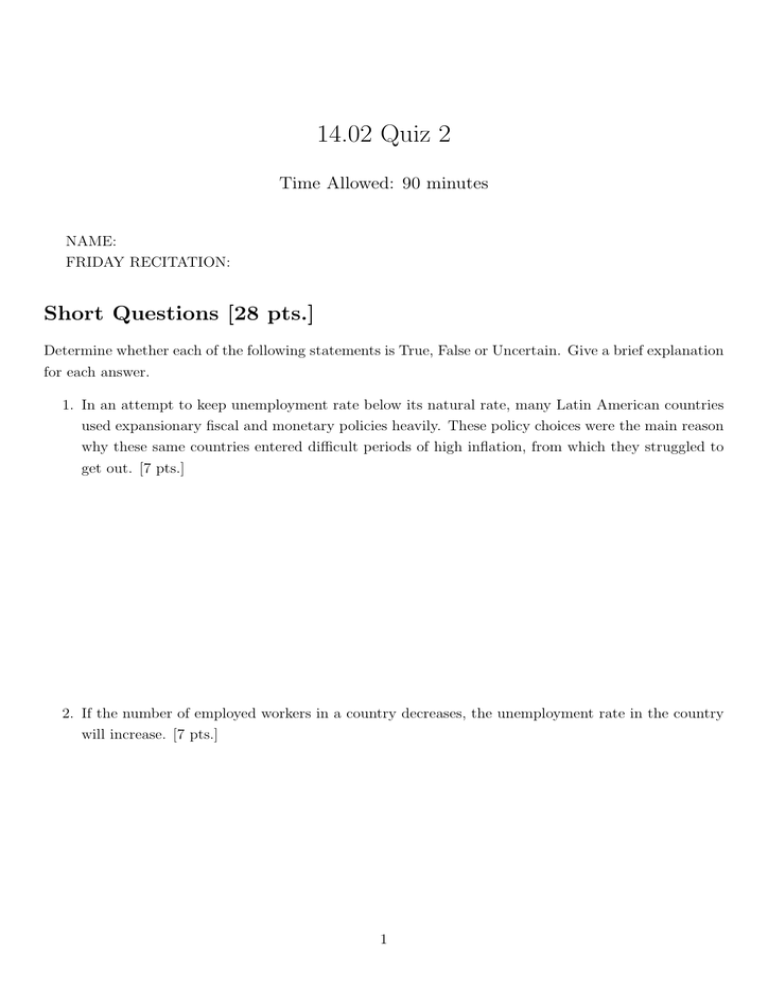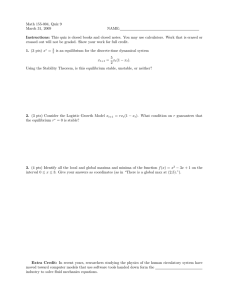Document 13421995
advertisement

14.02 Quiz 2 Time Allowed: 90 minutes NAME: FRIDAY RECITATION: Short Questions [28 pts.] Determine whether each of the following statements is True, False or Uncertain. Give a brief explanation for each answer. 1. In an attempt to keep unemployment rate below its natural rate, many Latin American countries used expansionary fiscal and monetary policies heavily. These policy choices were the main reason why these same countries entered difficult periods of high inflation, from which they struggled to get out. [7 pts.] 2. If the number of employed workers in a country decreases, the unemployment rate in the country will increase. [7 pts.] 1 3. An increase in the duration of unemployment should be linked to a decrease in flows in and out of unemployment, if one is to keep unemployment constant. [7 pts.] 4. Workers reluctance to take nominal pay cuts offers a feasible explanation of why the Phillips Curve relation breaks down when there is deflation. [7 pts.] Long Question 1: Animal Spirits [26 pts.] Consider the following quote on investment from The General Theory of Employment, Interest and Money, the seminal book written by John Maynard Keynes in 1936: “[...] most [...] of our decisions to do something positive, the full consequences of which will be drawn out over many days to come, can only be taken as a result of animal spirits - of a spontaneous urge to action rather than inaction, and not as the outcome of a weighted average of quantitative benefits multiplied by quantitative probabilities. Enterprise only pretends to itself to be mainly actuated by the statements in its own prospectus, however candid and sincere [...] if the animal spirits are dimmed and the spontaneous optimism falters, leaving us to depend on nothing but a mathematical expectation, enterprise will fade and die [...].” For the purpose of this test, we assume that what Keynes meant by “animal spirits” was really “business confidence”. This implies that investment I does not only depend on interest rate and income, but on “business confidence” as well. In light of this fact: 2 1. How does this affect the shape of aggregate demand? Starting from the investment curve and moving to the IS-LM model, graphically derive both an optimistic AD (i.e. an AD curve which embeds high business confidence) as well as a pessimistic AD (i.e. an AD curve which embeds low business confidence). [13 pts.] 2. If animal spirits (business confidence) do indeed play a role in the economy, what does their presence imply about the potential tools policymakers have at their disposal for affecting output in the short run? Apart from monetary and fiscal policy, suggest a new type of policy that could be used for increasing or decreasing output in the short run (be specific in how the policy would affect output). [13 pts.] 3 Long Question 2: Fire at Will [46 pts.] 1. Starting from the wage setting relation and the price setting relation, derive an expression for aggregate supply. Make sure you clearly explain each steps in the derivation. [11 pts.] Italy’s Prime Minister, Mr. Mario Monti, has presented to the Italian parliament a proposal to change labor laws. The Italian government claims that the new measures would “create a dynamic, flexible and inclusive labor market, one able to [...] create good working conditions [...]”. We interpret these proposals as a decrease in firing and hiring costs, i.e. a decrease in the variable z, the parameter in the wage setting relation. 2. Using the wage setting relation and the price setting relation you derived in part 1, predict what will happen to the unemployment rate in the medium run un if these labor proposals are approved by parliament. [6pts.] 3. How will the change predicted in part 2 affect the AS-AD equilibrium? Show using the AS/AD graph. Let E be the initial medium rum equilibrium. Let the first short-run equilibrium the economy transitions to be labeled as E " and the new medium run equilibrium as E "" . [6 pts.] 4 We now assume that these new labor market measures do pass in Italy’s parliament. We also assume that Italy has complete monetary autonomy, and that the objective of the central bank is to maintain a constant price level, P = PE (note that this is equivalent to a zero inflation target). 4. What kind of monetary policy should the Bank of Italy choose to achieve its goal? Explain your answer, describe the mechanics through which the economy goes from the initial medium run equilibrium to the new one and use an AS/AD graph to trace the effect of the appropriate monetary policy on the medium run equilibrium. [6pts.] 5. Assume that the Italian economy is characterised by the following dynamics: 1 ut − ut−1 = − (gy,t − 3%) 3 2 πt − πt−1 = − (ut − 5%) 3 gy,t = gm,t − πt where ut is the unemployment rate at time t, gy,t is the output growth rate at time t and gm,t the 5 nominal money supply growth rate at time t. Further assume that the length of the transition to the new medium run equilibrium is 1 year, and the absolute value of the change in unemployment needed to implement the Bank of Italy’s objective is |Δut | = 1% (note that this means 100 basis points, not 1% of 5%!). What should the nominal money growth rate gm,t be to achieve a constant price level (i.e. zero inflation)? Show your calculations. [11 pts.] 6. Italian GDP in 2011 was 2.3 trillion dollars. By how much is output (measured in dollars) going to change after the central bank has implemented its policy? Is Italian tax revenue going to increase or decrease after these measures are implemented? By how much? Assume that the aggregate tax rate is 30%. [6 pts.] 6 MIT OpenCourseWare http://ocw.mit.edu 14.02 Principles of Macroeconomics Spring 2014 For information about citing these materials or our Terms of Use, visit: http://ocw.mit.edu/terms.




